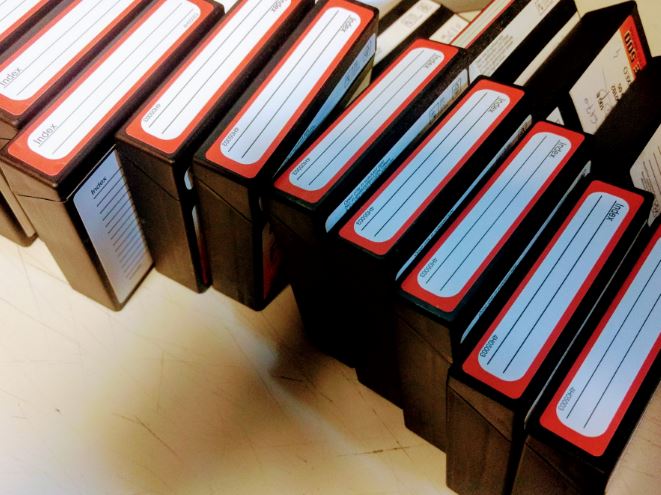Microfilming records is a solution to create documents on microform. These records are stored on microfilm for the insurance microform brings. With an estimated lifespan of over 500 years, this is one of the most important advantages of microfilm. Further aspects such as microfilm machine or the microfilming process need further analyzing from the user.
There are different types of microfilm to choose from. Choosing what type of microfilm is for you can be done by analyzing the advantages of microfilm or even the disadvantages it brings. We will try to bring you a step closer to understanding what is required to succesfully put records on microfilm.
Assessing the need for microfilming records
You have probably decided to start microfilming records. While you might do it with a service provider, let’s say you are not outsourcing. You are now talking with the stakeholders about the upcoming work. Colleagues in IT do not understand why you are going down this route. Still, you need their help as information has to be structured before starting.
Your supply department starts to order materials and consumables. You arrange with your supplier to have everything delivered in time. Operators are trying to get their head around what is going to happen. The hr department is preparing the working shifts for the operators. Seems your plan is bulletproof and nothing can go wrong.
Well, we hope it is like that and everything goes as expected. But just to be on the safe side, let’s look at some aspects more carefully.
Explaining the microfilming process for records
Microfilming records are the processes in which a record is put on microfilm. It is the actual road the documents and records made to the final part of the microfilming process. From the retrieval of the paper document to preparation. You will then probably scan the document. Also, you will have to index it. Next part of the process, is the preparation of records to be transferred to microfilm. Once that is ready, the actual filming process starts. While this is straightforward, your next task might be a bit challenging. You will have to process the microfilm to reveal the records on that film. In the following paragraphs, we will go into each step in-depth.
To better understand this process go to our page on the microfilming process explained.
The microfilm machine and the process of microform creation
In the following paragraph, we will be showing you good practices for the microfilming of records. To have good results, these good practices should be respected. It can be used as a checklist to successfully store records on microfilm.
Microfilming machine to create microfilm records
Microfilm equipment is not as high tech as it might seem. At the same time, it does have a fair bit of mechanics inside of it. Electrics also play a big part. While they are pretty reliable machines, they do sometimes go wrong.
What you can do is maintain it as good as you can. The operators should regularly clean the optics. Putting the machine in a dust free environment will clearly help. Then you go onto the cassette or film supports, depending on the manufacturer. There is some film motion going on inside of them to make sure everything is moving smoothly.
We recommend having a service contract. If not, at least regular service intervals for equipment will help. Last but not least, check for liquid spills inside processors. These could do serious damage.
We have a great article on the microfilm machine used in this industry.
Make sure your supply of materials is enough before starting microfilming records
Microfilming records seem quite straightforward. But there is some science behind organizing everything. Productivity is influenced mainly by how you organize the activity. You have to work in large batches. So it is sometimes better to not work at all during some days and process everything in one batch. Preparing equipment for work takes time, so it’s not feasible to do it for 3-4 rolls.
Most small jobs are combined with other small jobs or bigger ones. Costs also go down this way as you have less residue. Operators prefer working not waiting after machines or supplies. So make sure everything is in stock. You don’t want them stopping in the middle of work for lack of consumables. If they do that, they will have to restart the processor and that is time-consuming. The more they have to restart machines, the smaller the productivity.
Managing workforce while microfilming records
The workforce is a critical aspect of the microfilming process. They have to be experienced and be very practical persons.
You will notice that microfilming operators are very focused individuals. The process is not difficult, but it does require concentration for long periods. So yes, stamina always helps, but here it is decisive.
If you can not stay focused for long periods than maybe try something different. Operators also need to have distributive attention. Monitoring different parameters are necessary, while personal experience helps in noticing problems. Keep in mind, an operator is not only producing he is also monitoring quality parameters. If the output is not of high quality it can be refused by customers.
Human input provides the final touch in this process. The operators have to prepare, process and inspect the film. So take care of them and they will take care of you.
Information structure and roll indexation for the records on microfilm
Maybe this should be the 1st step. But we hope that putting it last you will remember this better. For this, you need the IT department to offer its help. See, microfilming records means moving the paper to film. In the transition phase, information will be digital. Therefore your it staff can help you to organize the digital files in folders based on indexes. These indexes will allow you to know at any time what information is where.
We have seen this becoming more advanced with software development. Some companies prefer developing specially made software for such tasks. Indexing and archiving based on logical structure is the way to go. Also, this structure has to be translated to film. You will retrieve from film much easier if you structure the information. Selective retrieval will happen for sure, so you want to be precise in choosing the right rolls.
Types of microfilm you can create
- 16mm microfilm with lengths of 30.5 or 66m. Can be written in grayscale or bitonal
- 35mm microfilm with lengths of 30.5 and 40m and 66m. Grayscale and bitonal is possible.
- Microfiche 105 x 148mm or non-standard. Grayscale and bitonal
- We recommend you go with silver halide film all across. It is now more cost effective to choose it.
You can have a more extensive look at this by checking our article on types of microfilm.
Advantages of microfilm records
- With LE500 film you get a lifespan of over 500years for the information you store.
- Very cost effective, as the price of film has not increased that much in the last 10 years.
- The creation process is pretty straightforward after you get used to the tasks.
- Silver Halide film is cheaper than it used to be so you can get better quality at a lower cost.
- Reduces the storage space when compared with traditional paper documents.
Our article on the advantages and disadvantages of microfilm provides extra information on this topic.
Conclusions about microfilming records
- Information is worthless without structure. The better the structure the easier the preparation for microfilming.
- The structure is critical for retrieval also. So you want to make sure the retrieval process will be quick and accurate.
- Human resources have a big part in this process. Well trained staff and good workflow help.
- The condition of the equipment plays a part in a smooth process. Clean regularly and maintain.
- Don’t overlook outside help. Regular maintenance and checks won’t harm anyone. It will be of benefit.
- Supply is a primary task. You should have everything arriving in time so you don’t have sudden stops.
- Last but not least, make sure everyone is pulling in the same direction. A happy team is a productive team.
We also recommend another article of ours on the beginner’s guide to microfilm.
Go also to google books and check out this book for an interesting read about the microfilm and its future.






